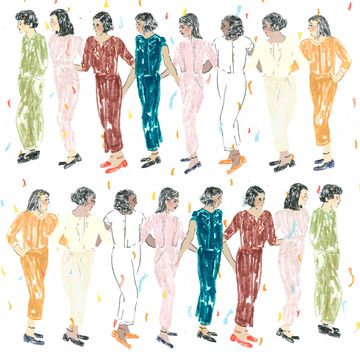On the internet, there is a video of an unidentified hand preparing miniature tacos. For scale, we see the hand light a tea candle, open a miniature stove's door, place the lit candle within, close the door, and then set a thimble full of oil on the stove's burner to boil.
The hand uses a bent paper clip to grasp four thumbprints' worth of dough, drop them in the oil, and then carefully fold them into shell shapes. The hand sautés a minuscule saucepan full of kernels of ground beef, and then it very carefully, with an almost-imperceptible shiver, slices a fingernail of lettuce into shreds. Finally, it arranges everything on a small table: four tacos, sized for a doll or pet rodent to eat, warm and waiting before the video ends.
This video has been viewed 25,000 times on YouTube. It's over a year old, but I first watched it this spring. And then watched it again. And then emailed it to everyone I knew. I did not watch it because I love tacos (although I did send it to my taco-loving friends). I did not watch it because I wanted to eat the meal prepared (which is rare: I spend many hours looking at recipes I know I would like to eat but don't really have the patience to gather the ingredients to cook). When I watched the video, I felt only a deep, intense longing. Not for food or for comfort, but for that very, very small world. It was a longing to shrink down and enter the screen and sit at the tiny table, stand by the stove, feel the heat of a votive candle as if it were a bonfire and not a single, flickering flame.
One of my most-read books when I was a child was a retelling of "Thumbelina" — a picture-book version, where Thumbelina was tucked into a walnut shell each night and gently rocked to sleep. She was also nearly married off to a blind, hideous, and oblivious mole. This last part I spent a lot of time thinking about. I sympathized with the mole, who was just looking for companionship, who must have heard Thumbelina's voice, finally at a timbre that his ears could register, who must have felt her soft hand in his paw, finally a size he could squeeze, and thought to himself in the dim twilight of his inner thoughts, This is it!
Although I understood Thumbelina's horror at her prospective spouse, at the thought of having to live underground with him and sully her gossamer clothes with dust, I still didn't think it was such a bad life. It seemed a bit unfair when the mole was portrayed, toward the end of their disastrous affair, as a grasping and jealous mate, one who should have been aware of his own inherent unattractiveness and let Thumbelina go.
In retrospect, I identified with the mole specifically because of his longing. I knew what it was like to encounter the miniature and wish to have it for yourself. What you would actually do with it once you got it was unclear. It somehow was both enough, and not nearly enough, simply to possess it. But I understood the longing of the hairy and squinting and wriggling mess of self to want something so tiny that its smallness became a signifier for something else, an emblem of a kind of perfection that is always out of reach.
Growing up, my sisters and I had a dollhouse. It was unpainted, made of a dark, rough wood, and styled as a Victorian monstrosity, gloomy looking, with high, sharp gables that could give you a splinter or cut your elbow if you grazed against them. The windows of that house had thick pieces of cellophane in them, to simulate glass, and the rooms were narrow and dark. But my two older sisters and I loved that dollhouse and played with it constantly. Our aunt had painstakingly sewn a cloth family to live in it: a mother in a beautiful red gingham dress with a lovely, tight little Afro of yarn along her skull; a father in tight black pants and a black suit coat, slim-cut, so that he looked ever-stylish and debonair; and various cloth children, boys and girls, as well as a sack of brown fabric that had been carefully stitched over to replicate the folds and lumps of a fat cloud of a toddler.
We had many games, but what I remember liking to do the most was to make miniature meals for the dollhouse's dining room. My mother bought me polymer clay and I would spend hours happily rolling and rerolling pebbles of it between my fingers, trying to fashion a bowl of oranges for the tiny dining-room table. I made miniature cherry pies and miniature turkeys with miniature drumsticks. I would place them carefully in the dark, rough rooms, and then wait. The emotion I felt was some combination of a gloating and longing: gloating because I had the tiny thing in my possession, and a longing because the possession was not complete and I did not know how to make it so. Sometimes, I reached my hand back into the room, took the little clay pie into my palm, and then placed it on my tongue. The taste, though pleasurable, did nothing to stop the longing. My tongue was coated with clay, but I wanted something else.
The Christmas I was 8 or 9, my sister announced she was going to build me another dollhouse, all by herself. I did not ask her for one, but I was delighted with this present: It was one of those rare moments in life when you receive a gift you do not even know you want. There happened to be a shop the next town over that specialized in dollhouses and train sets. It was a pleasure to go there, and that is where she picked out the house she would build for me.
I don't remember getting a say in the matter, but she picked the perfect house. It was wide and had balconies, with little French doors that opened out onto them. The dollhouse kit came with expensive-feeling heavy glass to insert into these doors, to make them more real. It came with so many yards of trim, for the gables and the eaves and the doorways. My sister spent weeks taking each piece out of the kit and arranging it on the carpet in the TV room, making sure each aligned with its number in the directions. She put it together entirely herself, and she designed the color scheme too: a cheerful canary yellow, with bright white for the curling borders.
Toward the end of the house's construction, my sister was painting the back wall when she overturned the paint can. There was a moment of silence in the room, and then a lot of lamenting. The paint spread over the rose-colored area rug, and despite our best efforts to scrub it clean, the stain remained for years, brittle and rough, a stiff, raised pond of gold over pink.
It was a big deal that the rug was stained because, by then, the rug was one of the few possessions our family owned. The year before, we had lost our house in my parents' divorce. We now lived in essentially three rooms in my grandparents' house — a large master bedroom that my grandparents gave up for my sisters and me, a smaller garret bedroom where my mother slept, and a room that for many years was used as a playroom for visiting grandchildren but was now converted into a kind of living room for my family.
My grandparents' house was a stately Victorian farmhouse, more impressive on the outside than on the in. The bedrooms were comfortable but small, and the hallways were dark and narrow. The whole house was oriented to the large, airy living room on the first floor, with its puffy, heavy white couches and Oriental carpets and fine pottery and wood-encased electronics. The room was dominated by two huge gilt mirrors that reflected the glamour of the room back to each other in an endless conversation. It was very much my grandmother's pride and joy and very much not ours.
My grandmother was a kind and generous person, loving to a fault, so it was not as if we were made to feel that it did not belong to us. But nothing could have been further from the cheerfully messy, determinedly '80s-style domesticity of what had been my mother's own living room, now lost in the divorce. In my grandmother's living room, there was an entire suite of porcelain and china and marble elephants and fisherman figures, all marching resolutely along the mahogany edges of her end tables. My mother's living room, in contrast, usually had a laundry basket in the corner and was littered with the detritus of girlhood — black Barbie-doll bodies twisted into triumphant, athletic poses and then dropped on the rug; brown baby dolls left to sweat out imaginary fevers on phantom hospital beds near the hi-fi stereo.
The upstairs room in my grandmother's house, where my sister was constructing the dollhouse for me, was supposed to be ours, was supposed to be a place for us to be girls together, still, uncramped and unedited. My mother did her best with the little money she had to decorate it just for us. She bought that rose-colored area rug, complaining all the while about the atrocious color and the poor quality, for $19.99 at Building 19, the local discount department store. She'd cursed that rug and mocked it, and we had, too, but when my sister spilled that lake of yellow on it, we all knew what it meant: We would now have this rose carpet with a yellow stain for a long, long time, because it would be ages before any of us could afford another one.
For the years afterward that we had that rug, in all the apartments we were evicted from, I would rub my bare feet and legs against the rough paint surface while watching TV and think about the moment the paint spilled, that moment of frustration and sadness and anticipation. I thought, too, about my dollhouse, which my sister finished for me, despite the accident. It was my pride and joy for many years, and many, many times I looked at it, at the foot of my bed in the room I shared with my sisters, and wished and wished that the house were real. That I could live inside a place that fine, that we could live in a place with doors along a balcony to carefully pull closed. It never occurred to me, the sadness of that gift she made, the beauty of the gesture: She literally tried to build me a home at a time when it felt that we had none.
That dollhouse is long gone: My mother made me throw it away when I was 13, after another eviction, and this time a move that felt final, to the projects. I hadn't played with it in years, but I still resented getting rid of it, and I have blocked out all memory of placing it on the curb for the trash. I only know that the perfect dollhouse family of brown cloth and black yarn went into Ziploc bags in a basement, along with a few of their ossified meals of brightly colored clay.
But the desire for that house remains. My sister, the one who built me the dollhouse, and I watch Tiny House Nation together when I come home to Boston. We talk about what it would take to live in one. Both of us have a dream, the same dream any kid who grew up poor has had: that one day, we will buy our mother a house. We reason we cannot afford a whole house for her in Boston, gentrification has ensured that, so a tiny house will be the answer. We will buy some undeveloped land somewhere, Concord, maybe, and we'll put up a little village of tiny houses for my sister and her husband and her children and our other sister and mother and me to live in. "I don't want to live in one of those," my mother laughs. "I've lived in small spaces for most of my life." And our other sister, the historian, says, "Slavery times are over. No one needs to live in a tiny house anymore."
The dream persists: a tiny house for each of us, with a loft bed and shelves, arranged around a center yard where we could meet and laugh and play before we retire at the end of the day, pulling the doors behind us on our own perfect, small place.
Kaitlyn Greenidge's novel We Love You, Charlie Freeman was published in March by Algonquin.















